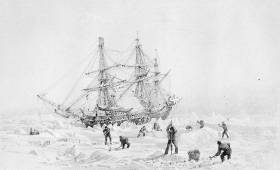Displaying items by tag: Sir John Franklin
The Search for Franklin - Kevin Cronin Speaks About His New Book
The disappearance of 129 people led by Sir John Franklin after they set out in 1845 to find a sea route to the Orient by way of the North-west Passage is one of the great mysteries of high-latitude exploration.
That’s what drew Kevin Cronin, a most unassuming Irish adventurer and seasoned sailor, along with documentary maker John Murray to collaborate with a Canadian team to find out more.
“Initially, I met a man called Paddy Barry in my student life, and he had a “why not” approach to sailing,” Cronin explains in an interview for the Wavelengths podcast.
Cronin sailed the Atlantic in Barry’s Galway hooker, Saint Patrick –which was, as he recalls, “way outside the comfort zone” of the wooden vessel with its tumblehome hull.
Cronin also participated in the award-winning voyage led by Jarlath Cunnane with Barry to circumnavigate the Arctic, spending several seasons steaming and sailing through the North-West and North-East passages.
Also on the Northabout crew for the North-West passage leg was John Murray, who was recording the voyage as part of a television documentary he was making on Franklin.
 Map of North West passage and King William island
Map of North West passage and King William island
While in Gjoa Haven, King William Island, Murray and Cronin met Canadian Tom Gross, who had, as Cronin records, devoted much of his life to unravelling the Franklin mystery.
Gross was cooperating with Dave Woodman, author of the “definitive” book on the importance of Inuit testimony in identifying the route taken by Franklin’s two ships, Erebus and Terror.
 (Above and below) Base Camp on Skull Island
(Above and below) Base Camp on Skull Island

That led to the formation of the Irish-Canadian Franklin Expedition in 2002, and over the years, Cronin has made many trips to the Arctic.
 Dave Woodman, expedition leader inspects skull remains found during search
Dave Woodman, expedition leader inspects skull remains found during search
The two ships were located in 2014 and 2016 - the first by staff of Parks Canada, close to where Cronin’s expedition had been – and the focus then turned to the location of Franklin’s grave and the fate of his crew.
 Snowmobile towing magnetometer over frozen sea in search of Franklin’s lost ships
Snowmobile towing magnetometer over frozen sea in search of Franklin’s lost ships
Cronin is returning this June to participate in an aerial survey seeking Franklin’s tomb. He has just published a beautifully illustrated book in which he has written about his experiences, and he spoke to Wavelengths about it.
 Kevin Cronin loaded up for land search for Franklin’s remains on King William Island
Kevin Cronin loaded up for land search for Franklin’s remains on King William Island
You can listen below
 The Search for Franklin – an Irish Connection is available at 15 euro plus five euro postage by scanning the QR code on the book publication invite, or by emailing Cronin at [email protected]
The Search for Franklin – an Irish Connection is available at 15 euro plus five euro postage by scanning the QR code on the book publication invite, or by emailing Cronin at [email protected]
Discovery Of Second Ship From Franklin's Lost Expedition May Rewrite History Of Northwest Passage
#HMSTerror - The discovery of what appears to be the wreck of the long-lost HMS Terror may rewrite the history of one of the biggest mysteries of polar exploration.
According to The Guardian, the nearly completely intact Vesuvius-class bomb vessel was found in a stroke of luck by researchers in an Arctic bay in the far north of Canada.
And their find was almost exactly 170 years to the day since the Terror and sister ship HMS Erebus were first trapped in polar ice northwest of King William Island in Victoria Strait.
Both vessels were part of an expedition by Sir John Franklin to complete the Northwest Passage in the 1840s, but Franklin did not live to see the final days of the ill-fated mission.
He was succeeded in June 1847 by Banbridge native Captain Francis Crozier, whose last known effort, as evident from a scrawled note from previous recovered records, was an attempt a year later to lead the remaining crew to safety along a river to the south, though no trace of their movements has been found.
However, the discovery of the Terror some 100km south of where it was previously believed crushed by the ice opens up a wealth of questions as to how Capt Crozier and his crew survived the extremes of the region for so long.
The Guardian has much more on the story HERE.





























































